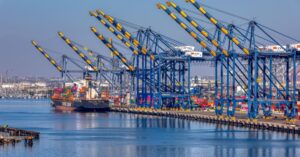The trucking industry has continued to struggle in what is one of the longest bearish markets in recent memory, resulting in carriers shutting down and many more downsizing. However, amid the turmoil, recent FTR data showed that Class 8 preliminary net orders were 18,900 units. That is up 25% from April and 37% from the year before. This is an interesting development considering the state of the market.
Read on for a recap of recent industry news, including the spike in orders for Class 8 vehicles and its cause, the payroll slide in the freight industry due to weaker demand, and why U.S. customs is tightening enforcement on low-value e-commerce trade.
Slowing Freight Market Not Enough To Impact Orders of Class 8 Trucks
The freight market has been experiencing a slowdown in activities, but according to both FTR and ACT Research, orders for new Class 8 trucks in North America remained strong in May.
FTR reported that preliminary net orders of Class 8 trucks were up 25% from April, totaling 18,900 units. Interestingly, despite the high numbers, the order still falls short of the 2023 order pace — a pointer that the market may have some effect after all. On the other hand, ACT Research reported even higher preliminary net orders at 23,200 units, a 46% increase from April and 49% year-over-year.
While seasonally slower demand is typical for Q2, ACT suggests open build slots and manufacturer balancing pre-buys may have influenced May’s order activity.
Prolonged Freight Demand Slump Impacting Jobs in The Trucking Industry
The Bureau of Labor Statistics has reported a loss of 5,400 trucking jobs in May, the largest monthly decline since August 2023.
Following the report, the total job losses in the past year are 29,600. However, experts attribute this decline to an oversupply of drivers spurred by the pandemic boom. The boom attracted many of these drivers, but now, they must compete for fewer cargo opportunities as the demand and supply dynamic doesn’t favor them anymore, leading to wage cuts. Smaller companies and independent owner-operators who went into the market during the peak period of the pandemic are now forced out because they can’t keep up with other players in the industry.
Some experts predict a turnaround in freight demand within the next few months, fueled by increased consumer spending and retailer restocking efforts.
U.S. CBP Cracks Down on De Minimis Misuse for Low-Value Shipments
The de minimis law allows importing goods worth up to $800 without duties and formal customs declaration, but it is now being taken advantage of to an alarming degree.
This is the case, particularly for e-commerce platforms operating out of China. Other nefarious stakeholders exploit the system to smuggle illegal goods or avoid tariffs. To curtail this, the CBP has suspended several customs brokers because they failed to comply with data filing requirements and proper classification/valuation of goods.
However, experts fear the move will disrupt the fast-growing e-commerce and create an uneven playing field for compliant brokers. For their part, lawmakers are considering measures to restrict the de minimis benefit for China or collect more data on low-value shipments.
Despite these moves, the $800 de minimis threshold is unlikely to change, but restrictions on China or better data collection for low-value shipments are possible.
Port of Baltimore Gears Up for Full Recovery
The Port of Baltimore has fully reopened after the Francis Scott Key Bridge collapse in March, which limited access to the main shipping channel in the region.
Major ocean freight carriers like Maersk, MSC, Hapag-Lloyd, ONE Line, and OOCL have resumed or are expanding services at the Port of Baltimore. To get the port back to operation, the White House Supply Chain Task Force led a coordinated effort to address potential bottlenecks and support a smooth transition back to full operations. The team worked with the Department of Agriculture to adjust shipping schedules for food producers, and the Department of Commerce to collaborate with retailers to minimize disruptions.
In the coming months, we can expect increased cargo volume at the Port of Baltimore and potential congestion as operations return to normal.
Onshoring, Nearshoring, and Reshoring Are on The Rise, But Why Is It Happening?
The COVID-19 pandemic disrupted global supply chains and underscored the risks of relying heavily on distant suppliers, accelerating the shift toward onshoring, nearshoring, and reshoring.
Companies are increasingly looking to bring production closer to home (onshoring) or to nearby countries (nearshoring/reshoring) for more control over their supply chains. This way, they have shorter transit times, more control over the quality, and improved responsiveness to customer needs. However, some challenges exist, such as infrastructural limitations and a potential lack of skilled labor. The trend of onshoring, nearshoring, and reshoring is likely to continue, but companies need to carefully weigh the risks and rewards before making a decision.
A successful strategy will consider not just short-term gains but also long-term resilience.
Canada Border Agent Strike Averted (For Now)
A potential strike by Canadian border agents, initially planned for June 7, has been called off.
Labor negotiations between the union and the government were extended to Wednesday, June 12. It was a relief for many supply chains because a strike could have caused problems for businesses that relied on the border. However, the strike was not uncalled for, seeing that the border agents, represented by the Public Service Alliance of Canada (PSAC) and the Customs and Immigration Union (CIU), have been without a contract for two years.
Talks are ongoing, with a potential deal on the horizon, but the situation remains uncertain until a new contract is reached.
Seamless Logistics With COGISTICS Transportation
With COGISTICS Transportation, complexity becomes clarity, and logistics becomes a competitive advantage. If you are searching for ocean freight operations or need expedited freight services to ensure your inventory reaches you as planned, look no further. Leveraging over 30 years of expertise, we provide innovative, technology-driven logistics solutions by land, air, and sea — around the clock, around the world. Connect with us today.




